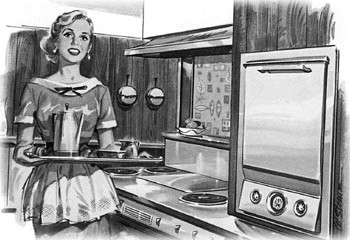![[MetroActive Features]](/gifs/feat468.gif)
![[MetroActive Features]](/gifs/feat468.gif)
[ Features Index | Sonoma County Independent | MetroActive Central | Archives ]
Better Living
Retro Bait: Now you're cookin' with gas!
Dreaming about a new dream home
By Donella H. Meadows
ON THE COVER of the newspaper's Sunday magazine section "The New American Dream Home" invites us to enter its softly lit, splendidly arched, mostly glass, double front door. An arrow points to the "Kitchen: Adjoining 'great room' and eat-in nook give busy families space to congregate; a countertop personal computer lets the cook fetch recipes or the kids do homework."
Then there's the "Master bedroom: A dual-sink vanity gives two-career couples space during the morning rush; a jetted tub and separate sitting room create a cozy retreat."
"Office: Careerists and telecommuters want it wired for computer modem, cable, Internet access, phone, fax."
"Garage: Many two-car families add a third bay where they store the bikes, the barbecue, the tools."
You can't look at that perfect house without imagining the perfect family living inside. Big house equals happiness. They've been selling us that dream for decades. When I was a kid, my family drove around glitzy subdivisions, and I fantasized how wonderful it would be to live in a house like that.
According to the Sunday supplement, the dream homes I was seeing back then were a lot smaller. Mid-1940s: 1,200 square feet, 3 bedrooms, 1.5 baths, small living room and kitchen, median price $7,500--2.7 times the median family income of $2,685 per year. Mid-1970s: 1,600 square feet, fireplaces, air conditioning, larger kitchen, 2.5 baths, median price $39,300--3.3 times the average household income of $11,800. Mid-1990s: More than 2,000 square feet (the one in the picture is 4,340), 3 baths, 9-foot ceilings, many more windows, much bigger kitchen, median price $133,900--4.15 times the average income of $32,265.
The dream house becomes ever more inaccessible.
The magazine lists more wonders--granite countertops, his and her walk-in closets, fireplace and TV in every bedroom, media room, exercise room, special wine cooler in the kitchen, and "computers in every room so family members can e-mail one another rather than shout."(I guess you would have to shout with such a huge house.)
The purpose of that article, of course, is to practice the great American art of making us dissatisfied with what we've got.
That particular piece even tells us, without the slightest hesitation, what we want:
"Who you are: Couple over 35, kids in middle or high school."
"What you want: One or two stories, four or five large bedrooms, separate formal living and dining areas."
"Who you are: Childless couple over 50, self-sufficient, active leisure life."
"What you want: One story, two or three large bedrooms, large master bedroom/retreat, guest suite, formal and informal dining, three-car garage." (What's that bedroom/retreat a retreat from? The empty rest of the house?)"
It's easy to make fun of this pretentiousness, but something in us does get hooked, as one can see by driving around today's glitzy subdivisions. Private palaces sprout like mushrooms on 5-acre lots, spreading over prime farmland, leveling forests. I see each of them as a standing demand for water and energy (imagine the heating bill for those high ceilings and huge windows; imagine the gas for mowing those acres of lawns!), plus roads, plowing, garbage pickup, sewage disposal. My friends from other countries, who carry on satisfying lives in one fourth or one tenth as much house, ask me what social or community failure drives us to surround ourselves with so much built space?
I'm sensitive on this issue, because I'm beginning to design my own dream home. What I want bears no resemblance to what the magazine so smoothly assumes. I keep my recipes on 3-by-5 cards, not a computer, and my clothes don't need a room of their own. I want a house that can function when the fossil fuel era is over, a house that doesn't trash the planet to be built and maintained, a house the average teacher, mechanic, farmer, librarian, secretary, painter--even newspaper columnist--can afford.
An article about my Dream Home would read:
Space: Compact but gracious; enough for privacy, but not enough to accumulate piles of unnecessary, unused stuff.
Energy: Little needed because of efficient construction; most energy from the sun; wood backup; no monthly bills.
Water: Low-flow faucets; efficient appliances; graywater recirculated; biological wastewater purification.
Land: Homes tightly clustered; on marginal land, not prime farmland; open space permanently protected and shared by neighborhood; little lawn; lots of garden.
Material: Non-toxic, low maintenance, produced sustainably.
The good news, I'm discovering, is that there is a whole new profession of "green" designers, architects, builders, and engineers who can help me figure out how to build that kind of New American Dream Home.
[ Sonoma County Independent | MetroActive Central | Archives ]
Copyright © Metro Publishing Inc. Maintained by Boulevards New Media.

Progressive Architecture
From the Aug. 27-Sept. 3, 1997 issue of the Sonoma County Independent.